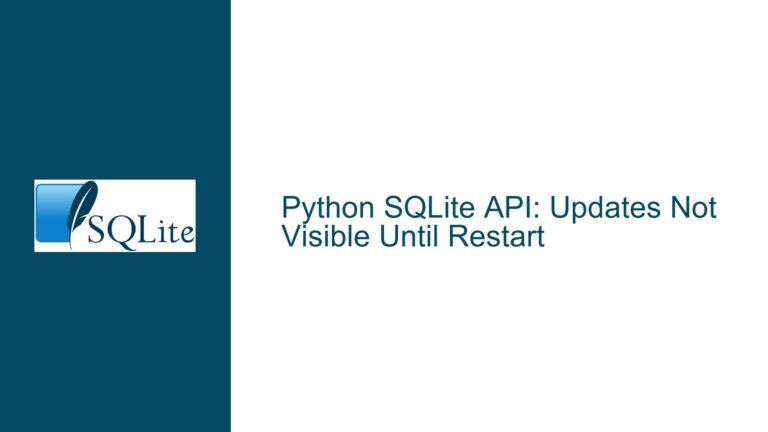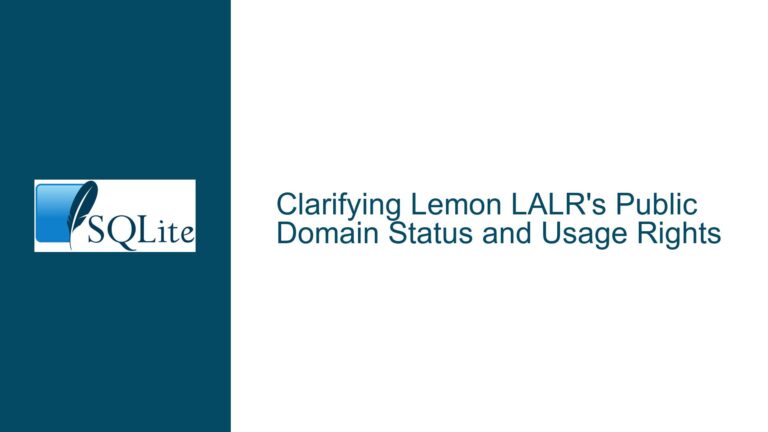Evaluating Page-Level Checksums in SQLite: Reliability and Performance Trade-offs
Understanding SQLite’s Page-Level Checksum Reliability Against Data Corruption
The integrity of data stored in SQLite databases is a critical concern, particularly when considering mechanisms to detect unintended modifications. The checksum VFS (Virtual File System) extension provides a method to compute checksums at the page level, enabling SQLite to avoid rewriting unchanged pages and detect corruption. However, trust in this mechanism depends on understanding its limitations, collision probabilities, and operational context.
Checksum Design and Collision Resistance
The checksum VFS uses a 64-bit checksum by default, which is not cryptographically secure. While this is sufficient for detecting accidental changes (e.g., bit flips due to hardware faults), it is vulnerable to malicious alterations. A 64-bit checksum provides 1 in 18.4 quintillion collision resistance under random changes. For context:
- Single-bit errors are always detected due to checksum sensitivity to bit position.
- Multi-bit errors have a detection probability of 1 – (1 / 2^64). This means cosmic-ray-induced errors or storage media faults are highly likely to be caught.
However, deliberate attacks exploiting checksum weaknesses could engineer collisions. For example, an adversary with knowledge of the checksum algorithm might alter multiple bits in a page to produce the same checksum. Cryptographic hashes (e.g., SHA-256) are better suited for adversarial scenarios but incur higher computational overhead.
Comparison to Row/Field-Level Change Detection
SQLite’s default behavior involves comparing individual rows or fields to avoid redundant writes. This granular approach ensures minimal I/O but requires:
- Tracking modifications at the row level.
- Complex logic to determine whether indexes or related structures require updates.
Page-level checksums simplify this by treating the entire page as a single unit. If the checksum of an in-memory page matches its on-disk counterpart, the page is not rewritten. This reduces per-row comparison overhead but introduces new trade-offs:
- False negatives: A changed row in a page with an identical checksum (due to collision) would go undetected.
- Storage overhead: Checksums add 8 bytes per page (for 64-bit), increasing database size marginally.
Error Detection in Modern Storage Systems
Modern storage devices employ Error-Correcting Codes (ECC) and redundancy to mitigate bit errors. Checksums in SQLite complement these mechanisms by providing application-layer validation. For example:
- Silent data corruption: Rare but catastrophic events where storage hardware fails to detect errors.
- Software bugs: Application-level logic errors that corrupt data before it reaches the disk.
Page-level checksums act as a final line of defense, ensuring that even if lower layers miss an error, SQLite can detect inconsistencies during page reads.
Assessing Performance Implications of Page-Level vs. Row/Field-Level Change Detection
Computational Overhead: Checksums vs. Byte Comparisons
The performance impact of checksums depends on two factors:
- Checksum calculation speed: A fast algorithm (e.g., CRC64) adds minimal latency.
- Comparison method: Comparing a 64-bit checksum is faster than comparing entire pages (e.g., 4 KB).
However, SQLite’s existing row/field comparisons are optimized for common cases:
- In-memory comparisons: If the original data is cached, byte-by-byte checks are faster than recalculating checksums.
- Selective writes: Only modified rows trigger index updates, whereas page-level checksums might force entire index pages to be rewritten.
For example, updating a single row in a table with 100 rows per page would require:
- Row-level: Compare the specific row’s fields.
- Page-level: Compute the checksum for the entire page after modification.
If most transactions modify few rows, row-level comparisons are more efficient. Conversely, bulk operations modifying entire pages benefit from checksums.
I/O Optimization and Write Amplification
Page-level checksums reduce write amplification by avoiding redundant page writes. This is particularly beneficial for:
- SSDs: Excessive writes degrade NAND flash longevity.
- Networked storage: Minimizing writes reduces latency in distributed systems.
However, checksums introduce read-before-write overhead. Before writing a page, SQLite must read the existing page to compare checksums unless the page is already in cache. This negates some performance gains, especially in low-memory environments.
Index Page Optimization Challenges
SQLite indexes (B-trees) complicate page-level checksum efficiency. For instance:
- Updating a table row may require updating multiple index pages.
- Row-level checks prevent unnecessary index updates if indexed fields remain unchanged.
With page-level checksums, even minor row changes could invalidate index pages, leading to more frequent writes. This negates the advantage of page-level deduplication unless indexes are rarely updated.
Practical Considerations for Implementing Page-Level Checksums in SQLite
When to Use Page-Level Checksums
- Read-Heavy Workloads: Databases with infrequent updates benefit from reduced comparison overhead.
- Large Pages: Configuring SQLite with larger page sizes (e.g., 8 KB) amortizes checksum costs over more rows.
- Corruption Detection: Applications requiring robust integrity checks (e.g., financial systems) pair checksums with periodic validation tools like
PRAGMA integrity_check.
Mitigating Checksum Collision Risks
- Upgrade to 128-bit Checksums: Modify the checksum VFS to use a longer hash (e.g., SHA-256 truncated to 128 bits). This reduces collision probability to 1 in 3.4e38, making accidental collisions practically impossible.
- Combine with Row-Level Checks: Use page-level checksums for coarse-grained detection and row-level validation for critical fields.
Implementation Steps and Code Modifications
- Enable Checksum VFS:
sqlite3_vfs_register(sqlite3_cksumvfs(), 1); - Benchmark Performance: Compare write throughput and CPU usage with/without checksums using realistic workloads.
- Customize Checksum Algorithms: Replace the default 64-bit checksum with a cryptographic hash for adversarial resilience.
Example: Detecting Corruption with Checksums
After enabling the checksum VFS, SQLite validates page checksums during reads. To manually verify:
PRAGMA page_size;
PRAGMA page_count;
-- Read each page and verify checksum
Automate this with a background thread or external tool to periodically scan the database.
Trade-offs in Codebase Complexity
Adopting page-level checksums simplifies certain aspects of SQLite’s write logic but introduces:
- Cache Management Complexity: Tracking page checksums in memory.
- Recovery Logic: Handling checksum mismatches during crash recovery.
For most applications, the existing row/field-level optimization remains preferable. Page-level checksums are a niche optimization suited for specific performance or integrity requirements.
This guide provides a comprehensive analysis of page-level checksums in SQLite, balancing reliability, performance, and implementation complexity. By understanding these trade-offs, developers can make informed decisions tailored to their application’s needs.






